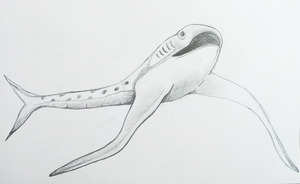Aquilolamna
| Aquilolamna | ||||||||||||
|---|---|---|---|---|---|---|---|---|---|---|---|---|

Artist's impression |
||||||||||||
| Temporal occurrence | ||||||||||||
| Turonium | ||||||||||||
| 93 million years | ||||||||||||
| Locations | ||||||||||||
| Systematics | ||||||||||||
|
||||||||||||
| Scientific name of the family | ||||||||||||
| Aquilolamnidae | ||||||||||||
| Vullo et al., 2021 | ||||||||||||
| Scientific name of the genus | ||||||||||||
| Aquilolamna | ||||||||||||
| Vullo et al., 2021 | ||||||||||||
| Art | ||||||||||||
|
Aquilolamna milarcae is a Cretaceous cartilaginous fish whose fossil remains were found in the deposit near Vallecillo in northeast Mexico . The species was likely a plankton eater similar to the manta rays or whale sharks . The scientific name refers to Aquila ( Latin eagle ) and the shark genus Lamna ( porbeagle ),the authors suggested eagle shark as a trivial name .
features
Aquilolamna is known so far from only one find (the holotype ), which includes the complete body. The animal lies flat on its stomach on the plate, except for the tail, which is seen from the side. The animal had a total length of 166 cm and a wingspan of the pectoral fins of 190 cm. This exceeding the body length by the wingspan distinguishes the species from all other known sharks.
The head is badly bruised in the holotype so that many details are not clearly visible. It is short and wide and makes up about 10% of the body length, has no noticeable snout and an almost terminal mouth . The jaws are long and reach the occiput . Teeth are not preserved. The pectoral fins are pronounced with a relatively broad base and point slightly forward in the shape of a sickle with the ends bent backwards. They are supported by at least 70 cartilage rays that point to the front edge of the fin and are partially bifurcated at the front end.
The trunk is slender and together with the head is 122 cm long. It has 105 vertebrae, the foremost of which are not fused, which rules out belonging to the rays . Dorsal, ventral or anal fins were not recognizable on the holotype, although it is unclear whether they were missing in the living animal or whether they were not preserved. In today's shark species, anal fins are often missing and the dorsal fins are variable and often opposite to the pectoral fins, so that a small or missing dorsal fin seems likely for Aquilolamna . Ventral fins, on the other hand, are present in all known shark species, also because they carry the male copulation organs ( clasps ), so that they were probably lost in the Aquilolamna holotype. Imprints of muscles and skin are present, the skin appears to be smooth and has no denticles . The 44 cm long tail has 120 vertebrae. The caudal fin is pronounced heterocercus with a 51 cm long, slender, about 27 ° upward and a stronger, 21 cm long and 55 ° downward lobe .
Way of life
The unusual body structure of Aquilolamna , which is not known from any other bony fish , suggests a plankton eater. He was probably an active but not very fast swimmer who mainly used his caudal fin and possibly to a lesser extent his pectoral fins as propulsion. Along with Aquilolamna on the same limestone slab one were ammonite ( Pseudaspidoceras pseudonodosoides ) and three bony fish found: the paving toothfish Paranursallia gutturosa (Family Pycnodontidae ) Goulmimichthys roberti (order crossognathiformes , Family Pachyrizodontidae ) and the lizards Fishy Rhynchodercetis regio (Family Dercitidae ).
Systematics
The higher systematic classification of Aquilolamna is partly uncertain, due to the shape of the vertebrae and the skeleton of the caudal fin, it is assumed to belong to the mackerel shark-like (Lamniformes), which also includes two of the more recent plakton-eating shark species, the basking shark ( Cetorhinus maximus ) and the Basking mouth shark ( Megachasma pelagios ). The Erstbeschreiber presented for the way to a new family to the next Aquilolamna also previously known only from mm by 2 large, hook-shaped teeth taxon Cretomanta could include possibly with Aquilolamna is equal then an older synonym would. Another species ( Platylithophycus ), known only from its gill arches and adjacent cartilage structures, and which was likely a large plankton eater, could belong in the same family.
Web links
literature
- Romain Vullo, Eberhard Frey, Christina Ifrim, Margarito A. González González, Eva S. Stinnesbeck, Wolfgang Stinnesbeck: Manta-like planktivorous sharks in Late Cretaceous oceans . In: Science . tape 6535 , 2021, pp. 1252-1256 , doi : 10.1126 / science.abc1490 .